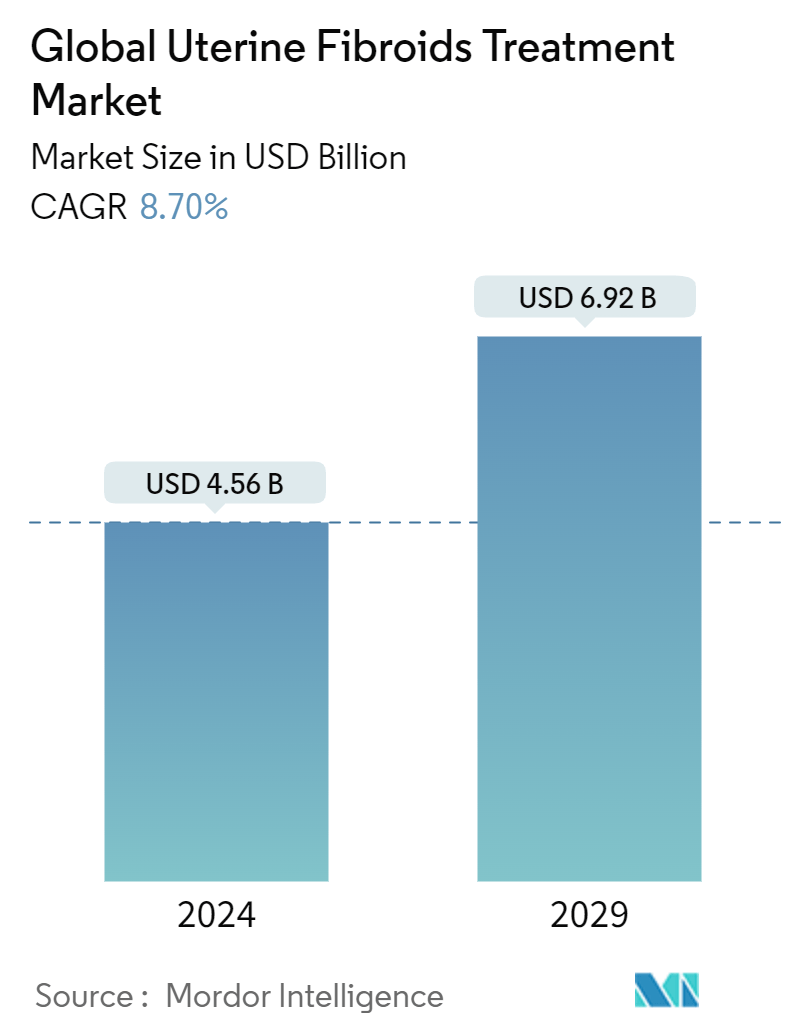Market Size of Global Uterine Fibroids Treatment Industry

| Study Period | 2019 - 2029 |
| Market Size (2024) | USD 4.56 Billion |
| Market Size (2029) | USD 6.92 Billion |
| CAGR (2024 - 2029) | 8.70 % |
| Fastest Growing Market | Asia-Pacific |
| Largest Market | North America |
Major Players
*Disclaimer: Major Players sorted in no particular order |
Uterine Fibroids Treatment Market Analysis
The Global Uterine Fibroids Treatment Market size is estimated at USD 4.56 billion in 2024, and is expected to reach USD 6.92 billion by 2029, growing at a CAGR of 8.70% during the forecast period (2024-2029).
The market is likely to be driven by the high prevalence of uterine fibroids among women worldwide, increased patient preference for less invasive procedures, and the introduction of technologically sophisticated technologies. For instance, an article published by Contemporary OB/GYN in February 2022 mentioned that over 70% of women worldwide are estimated to develop uterine fibroids by age 50. Such an increasing risk of uterine fibroids is expected to drive the demand for effective treatment, contributing to market growth. Uterine fibroids are highly common in middle-aged women. If undiagnosed, the fibroids can lead to severe complications. For instance, according to the article published by Frontiers Journal in March 2022, uterine fibroids, or leiomyomata, affect most women above 30 and have a high incidence of 75% among women of reproductive age.
On the other hand, rising market players’ strategies, such as product approvals and launches, partnerships, and agreements to develop effective treatments, are expected to boost market growth. For instance, in August 2022, Gedeon Richter Australia Pty Ltd received approval from the Therapeutic Goods Administration for its Ryeqo, which is indicated for treating moderate to severe symptoms of uterine fibroids in adult women of reproductive age. Additionally, according to a report published by Washington University in February 2024, combined Duke University’s development of a collagen-degrading enzyme with North Carolina Central University’s creation of LiquoGel, an injectable hydrogel-copolymer, to locally deliver therapeutic drugs for softening and potentially liquefying uterine fibroid tissues. This innovative approach promises a minimally invasive, non-surgical alternative to traditional treatments, enhancing patient outcomes and reducing associated healthcare costs, thereby propelling the growth of the uterine fibroids treatment market.
Hence, the availability of advanced products, technological advancements, and initiatives by various market players contribute to the overall market growth. However, complications associated with morcellators are expected to hinder the market growth over the forecast period.
Uterine Fibroids Treatment Industry Segmentation
As per the scope of this report, uterine fibroids, also known as uterine myomas or leiomyomas, are non-cancerous tumors that develop in the muscular wall of the uterus. They can vary in size and number. Symptoms include heavy menstrual bleeding (HMB), anemia, abdominal pressure and pain, bloating, increased urinary frequency, and reproductive dysfunction.
The uterine fibroids treatment market is segmented by type, treatment, end user, and geography. The type segment is further segmented into subserosal fibroids, intramural fibroids, submucosal fibroids, pedunculated fibroids, and other types. Other types include cervical fibroids. The treatment segment is further divided into drugs and surgical techniques. The drugs sub-segment is further divided into progesterone, levonorgestrel, and other drugs. Other drugs include mefenamic acid and raloxifene. The surgical techniques are further divided into hysterectomy, myomectomy, myolysis, and other surgical techniques. Other surgical techniques include uterine artery embolization (UAE) and radiofrequency ablation (RFA). The end user segment is further bifurcated into hospitals, specialty clinics, and other end users. Other end-user segments include outpatient centers, home healthcare services, and telemedicine platforms. The geography segment is further segmented into North America, Europe, Asia-Pacific, the Middle East and Africa, and South America. The market report also covers the estimated market sizes and trends for 17 countries across major global regions. The report offers the value (in USD) for the above segments.
| By Type | |
| Subserosal Fibroids | |
| Intramural Fibroids | |
| Submucosal Fibroids | |
| Pedunculated Fibroids | |
| Other Types |
| By Treatment | ||||||
| ||||||
|
| By End-user | |
| Hospitals | |
| Specialty Clinics | |
| Others |
| Geography | ||||||||
| ||||||||
| ||||||||
| ||||||||
| ||||||||
|
Global Uterine Fibroids Treatment Market Size Summary
The uterine fibroids treatment market is poised for significant growth, driven by the high prevalence of uterine fibroids among women globally and the increasing preference for less invasive treatment options. The market is characterized by the introduction of advanced technologies and innovative treatment methods, such as the development of collagen-degrading enzymes and injectable hydrogel-copolymers, which offer minimally invasive alternatives to traditional surgical procedures. The availability of effective pharmaceutical interventions, including gonadotropin-releasing hormone agonists, is also contributing to the market's expansion. The rising incidence of uterine fibroids, particularly among women of reproductive age, is expected to further propel demand for these treatments, fostering growth within the market.
North America is anticipated to hold a significant share of the uterine fibroids treatment market, supported by well-established healthcare facilities, government initiatives, and the presence of major companies offering technologically advanced treatment options. The region's market growth is further bolstered by the high prevalence of uterine fibroids, which are a leading cause of hysterectomy procedures and gynecologic hospitalizations. The competitive landscape of the market is marked by the presence of key players such as Myovant Sciences GmbH, Gynesonics, and Boston Scientific Corporation, who are actively engaging in strategies like mergers, acquisitions, and new product developments to maintain their market position. The approval of new products and the establishment of healthcare facilities dedicated to uterine fibroids treatment are expected to drive market growth in North America over the forecast period.
Global Uterine Fibroids Treatment Market Size - Table of Contents
-
1. MARKET DYNAMICS
-
1.1 Market Overview
-
1.2 Market Drivers
-
1.2.1 Technological Advancements in Uterine Fibroids Treatment
-
1.2.2 Growing Prevalence of Uterine Fibroids
-
-
1.3 Market Restraints
-
1.3.1 Complications Associated with Morcellators
-
-
1.4 Porter's Five Forces Analysis
-
1.4.1 Threat of New Entrants
-
1.4.2 Bargaining Power of Buyers/Consumers
-
1.4.3 Bargaining Power of Suppliers
-
1.4.4 Threat of Substitute Products
-
1.4.5 Intensity of Competitive Rivalry
-
-
-
2. MARKET SEGMENTATION (Market Size by Value - USD)
-
2.1 By Type
-
2.1.1 Subserosal Fibroids
-
2.1.2 Intramural Fibroids
-
2.1.3 Submucosal Fibroids
-
2.1.4 Pedunculated Fibroids
-
2.1.5 Other Types
-
-
2.2 By Treatment
-
2.2.1 Drugs
-
2.2.1.1 Progesterone
-
2.2.1.2 Levonorgestrel
-
2.2.1.3 Other Drugs
-
-
2.2.2 Surgical Techniques
-
2.2.2.1 Hysterectomy
-
2.2.2.2 Myomectomy
-
2.2.2.3 Myolysis
-
2.2.2.4 Other Surgical Techniques
-
-
-
2.3 By End-user
-
2.3.1 Hospitals
-
2.3.2 Specialty Clinics
-
2.3.3 Others
-
-
2.4 Geography
-
2.4.1 North America
-
2.4.1.1 United States
-
2.4.1.2 Canada
-
2.4.1.3 Mexico
-
-
2.4.2 Europe
-
2.4.2.1 Germany
-
2.4.2.2 United Kingdom
-
2.4.2.3 France
-
2.4.2.4 Italy
-
2.4.2.5 Spain
-
2.4.2.6 Rest of Europe
-
-
2.4.3 Asia-Pacific
-
2.4.3.1 China
-
2.4.3.2 Japan
-
2.4.3.3 India
-
2.4.3.4 Australia
-
2.4.3.5 South Korea
-
2.4.3.6 Rest of Asia-Pacific
-
-
2.4.4 Middle East and Africa
-
2.4.4.1 GCC
-
2.4.4.2 South Africa
-
2.4.4.3 Rest of Middle East and Africa
-
-
2.4.5 South America
-
2.4.5.1 Brazil
-
2.4.5.2 Argentina
-
2.4.5.3 Rest of South America
-
-
-
Global Uterine Fibroids Treatment Market Size FAQs
How big is the Global Uterine Fibroids Treatment Market?
The Global Uterine Fibroids Treatment Market size is expected to reach USD 4.56 billion in 2024 and grow at a CAGR of 8.70% to reach USD 6.92 billion by 2029.
What is the current Global Uterine Fibroids Treatment Market size?
In 2024, the Global Uterine Fibroids Treatment Market size is expected to reach USD 4.56 billion.

